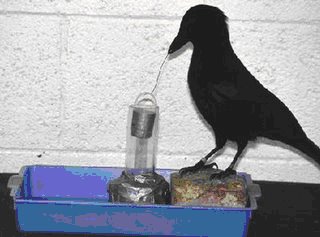National Geographic, March 2008
Thirty years after the Alex studies began, Pepperberg and a changing collection of assistants were still giving him English lessons. The humans, along with two younger parrots, also served as Alex’s flock, providing the social input all parrots crave. Like any flock, this one—as small as it was—had its share of drama. Alex dominated his fellow parrots, acted huffy at times around Pepperberg, tolerated the other female humans, and fell to pieces over a male assistant who dropped by for a visit. (“If you were a man,” Pepperberg said, after noting Alex’s aloofness toward me, “he’d be on your shoulder in a second, barfing cashews in your ear.”)
continue…
More….
Susan Savage-Rumbaug TED talk on bonobos and language
- Title: Betty retrieving bucket with wire 3
- Description: From the hook/wire experiment, this shows Betty retrieving the bucket from the well with wire she has just bent.
Betty is a New Caledonia crow.



Thanks!!! This really helped with my project!!!!